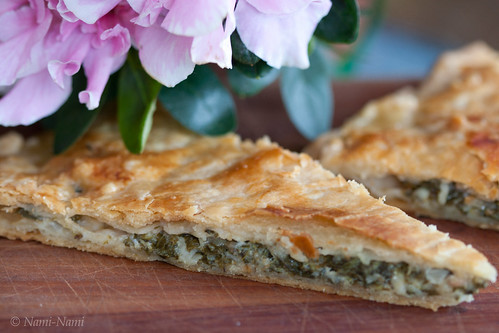
Originally posted here.
A well-known (and much-hated) garden pest, ground-elder (Aegopodium podagraria, also known as bishop's weed and goutweed in English, naat in Estonian) has a long history of being used for medicinal purposes. However, it was also cultivated as a food crop in the Middle Ages, especially in Russia (and in Siberia in particular - the Russian Saint Seraphim of Sarov is said to have survived three years on eating mainly ground-elder while on self-exposed exile in a deep forest), Scandinavia, in Central Europe. Old Finno-Ugric peoples were keen consumers of ground-elder, too. According to some sources, old traders wrapped their vegetables into ground-elder leaves to keep them fresh looking and smelling - the leaves are high in essential oils and helped to keep the other produce fresh and aromatic, too. Young and tender ground-elder leaves can be added to soups, omelettes and stews. Blanched leaves can be mixed with cottage cheese and curd cheese. The leaves are high on Vitamin E, as well as vitamin C, they're rich in antioxidants, minerals, flavonoids and fibre. Dishes containing ground-elder are easily digestible, and have cleansing properties - so they're good for that spring-time detoxing :)

Make sure to use only very young ground-elder/goutweed leaves (like those on the photo above) - the big ones tend to be too bitter and rough. Pamela Michael, a well-known "herbal cook" and author of Edible wild plants and herbs, writes that "those of us who suffer from the weed in our gardens, should rejoice in the knowledge that we can eat the pest" :)
Intrigued? You can also use young ground-elder leaves to make delicious spring-time vanilla-scented muffins.
Ground-elder and cottage cheese pie
(Kevadine naadipirukas)
Serves 8 to 10

Pastry:
200 g butter
200 g sour cream
350 g all-purpose flour
a pinch of salt
Filling:
100 to 200 g young ground-elder leaves
1 Tbsp oil
one large onion (about 100 g)
300 to 400 g cottage cheese, drained
1 egg
1 tsp dried oregano
sea salt and freshly ground black pepper
Make the pastry: melt butter over moderate heat. Take the saucepan off the heat, stir in sour cream, flour and salt. Stir until well combined, then place into the fridge for about 30 minutes to rest.
Make the filling: wash the goutweed leaves carefully, drain lightly. Place onto a dry hot skillet and heat until wilted. Then rinse quickly under cold running water to stop the leaves from cooking further. Press to dry the leaves thoroughly, then chop roughly.
Heat oil on a heavy frying pan, add onion and sauté gently for about 10 minutes, until the onion softens. Add the chopped ground-elder leaves, cottage cheese, oregano, salt and pepper. Give it a stir, then add most of the egg and stir again.
Take the pastry out of the fridge, divide into two. On a flour-dusted table, roll out one of the pastry pieces into a large circle (approximately 40 cm in diameter or whatever the size that fits your oven sheet). Transfer onto a lined oven sheet, spoon the filling on top. Roll out the other pastry and cover. Press the edges tightly together, prick the top with a fork here and there.
Brush with an eggwash. Bake in a preheated 200 C oven for about 25-30 minutes, until the pie is lovely golden brown on top.
- Follow RecipesDream
- Follow @us
